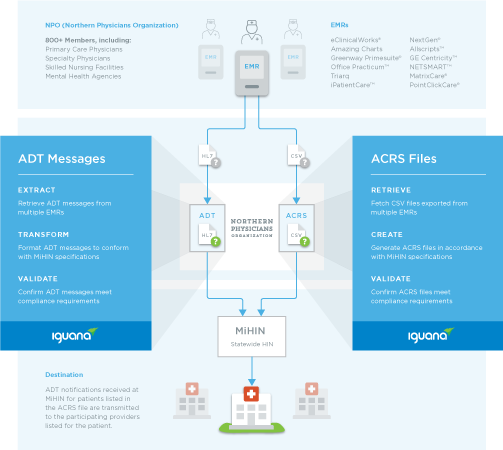
Welcome to the third post of our blog series Improving Care Coordination with Integration. In this post, we will share the ways in which Iguana was used to complete projects for the Northern Physicians Organization (NPO) as we discuss the importance of health information exchange (HIE) in the healthcare industry.
What is an HIE?
A health information exchange (HIE) is the electronic transferring of healthcare information among medical facilities, healthcare professionals, and organizations. It typically refers to the act of transferring data but can also refer to an organization responsible for facilitating this exchange. HIE’s make it possible for healthcare professionals to share, access, and retrieve complete patient health information electronically.
Why are they significant?
An HIE is important because it helps to facilitate care coordination. Care coordination is defined as “…deliberately organizing patient care activities and sharing information among all of the participants concerned with a patient’s care to achieve safer and more effective care.” HIE’s assist in providing healthcare professionals with patient information and allowing them to communicate this information with each other. This allows different healthcare providers across various hospitals and facilities to be informed about patient records and their status.
This helps with:
- Improving transitions of care
- Reducing duplicative tests
- Monitoring patient movement
- Identifying high utilizers
NPO Perspective
The Michigan Health Information Network (MiHIN) is a public and nonprofit HIE that supports the statewide exchange of health information to make valuable data available at the point of care. The MiHIN sits at the center of care coordination efforts in Michigan and has the goal of streamlining the flow of healthcare information, so patients are never far from their medical records.
What Iguana Was Used To Do
ADT Notification Professional Services Project
ADT notifications are sent when a patient is admitted to a facility, transferred to another facility, or discharged from a facility. These notifications are sent to update physicians, care management teams and other caregivers on a patient’s status and are the foundation to improving care coordination through the exchange of health information.
iNTERFACEWARE’s professional services team was contracted by NPO to support the sending of notifications from several skilled nursing facilities on the status of patients’ care transitions.
Iguana was used to:
- Retrieve ADT messages from several long-term post-acute care EMRs including Netsmart, MatrixCare, and PointClickCare
- Transform the ADT messages for conformance with the MiHIN specifications
- Validate ADT messages against the conformance requirements
Once records are validated, the newly transformed ADT messages are sent to MiHIN for insertion into the statewide ADT service environment.
ACRS Professional Services Project
MiHIN’s Active Care Relationship Service (ACRS) solution identifies providers who are actively caring for a patient and enables these providers to receive notifications when there are updates to the status of a patient’s health or care plan. ACRS allows organizations to submit data files which record care team relationships attributing a particular patient with healthcare professionals at that organization.
When MiHIN receives an ADT notification, the patient and providers who are on that patient’s care team are looked up using the ACRS. MiHIN then looks up the providers in the Health Provider Directory to determine the transport method by which providers prefer to receive ADT notifications.
iNTERFACEWARE’s professional services team was contracted by NPO to submit data files to MiHIN to document care relationships between a particular patient and healthcare professionals from over 50 organizations.
Iguana was used to:
- Extract the input CSV files from several EMRs: eClinicalWorks®, NextGen®, Allscripts™, Amazing Charts, GE Centricity™, Greenway Primesuite®, Netsmart™, Triarq, Office Practicum™, and iPatientCare™
- Create the necessary ACRS patient-to-provider attribution files
- Validate all records against MiHIN conformance requirements
- Generate error notification and process completion reports
Once the ACRS attribution files are validated to conform to the MiHIN requirements, the files are sent to MiHIN to create new recipients in the statewide ADT service environment.

Next week, we will discuss reimbursements and the significance of these projects as the structure for reimbursements in healthcare are changing.
